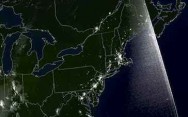
Imagine 10 days of a catastrophic blackout across the United States. No cell phone service, no ATM withdrawals, no working street lights, no available gasoline … no escape. Fact:It could happen.
Sunday week, October 27, at 9 p.m. ET/PT, American Blackout airs. National Geographic’s two-hour, edge-of-your-seat movie event imagines the story of a national power failure in the United States caused by a cyberattack — told in real time, over 10 days, by those who kept filming on cameras and phones. You’ll learn what it means to be absolutely powerless. Let down by the power companies who are doing little to guard against this eventuality
Gritty, visceral and totally immersive, see what it might take to survive from day one, and who would be left standing when the lights come back on.
American Blackout combines startling user-generated footage from recent real blackouts and disasters like Hurricane Sandy intercut with the dramatic shot footage in feature film style. Follow the struggles of ordinary Americans wrangling through the chaos, and witness one prepper family who prepared for the worst.
Hacking into urban infrastructures isn’t science fiction anymore; cyberthreats and the weaknesses of the grid are in the news every day. In fact, cyberattacks can indeed cause power surges that physically damage electrical equipment. Said Leon Panetta, the former U.S. Secretary of Defense: “The next Pearl Harbor we confront could very well be a cyber-attack that cripples our power systems, our grid, our security systems, our financial systems.”
Extrapolating from previous disasters and expert opinion, American Blackout dramatizes this very concept.
“American Blackout not only plays like a true thriller, making you think twice about how prepared you might be if (and more likely when) this actually happens, but also should be a powerful tool to inspire discussion on what we can do to strengthen our defenses from such an attack,” said the NatGeo press release.
Often called the largest machine in the world, the U.S. electrical grid connects Americans to 5,800 major power plants and includes more than 450,000 miles of high voltage transmission lines. Seventy percent of key power grid components are more than 25 years old, and the average age of power plants tops 30 years.
A 2013 congressional report on grid vulnerability revealed that more than a dozen utilities reported “daily,” “constant” or “frequent” attempted cyberattacks, with one reporting approximately 10,000 attempts per month. And in the past decade alone, an estimated 679 widespread power outages occurred due to severe weather, costing the U.S. an annual average between $18 billion and $33 billion.
Don’t think you’re vulnerable? Think again. America’s energy, water, communications and financial networks are intricately connected. Even minor disruptions in this modern framework can cause major disruptions of our lives … a major outage could be disastrous. Recent winter storms and hurricanes have exposed this weakness. Think stuck subways, grounded flights, domestic fires from candlelight, panicked buying at stores, downed ATMs and closed schools and businesses.
For ordinary Americans navigating the turmoil, the question arises: When does civility and morality change to hostility? How safe would your home or workplace be? Who is apt to survive?
To capture the reality of a catastrophic blackout while telling a dramatic feature-length story, filmmakers used actual disaster footage alongside user-generated video blogs and scripted material. The result blends the three sources seamlessly, telling one tale of America in the dark that will leave you breathless.
American Blackout focuses on five different storylines: A family about to have a baby in California, and using a handycam; a teenage guerrilla filmmaker in Austin; students in an elevator in Arizona using their phone cameras; a New York City couple trapped in a penthouse filming with their phone camera; as well as a prepper family in Colorado using a camcorder.
Unlike the other ordinary Americans, the preppers have a generator that provides charging capabilities for their camcorder and have stockpiled supplies, devices and weapons. But when the SHTF, what would they do? How would they use their bunkers, vast security systems and stockpiled resources? Would they help or harm others?